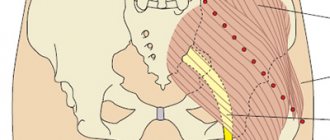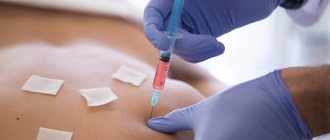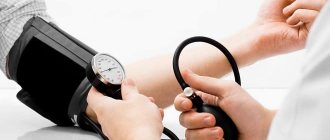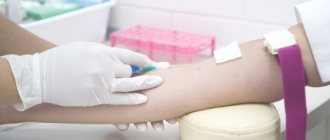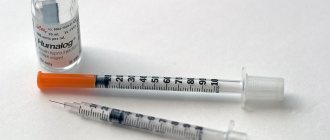Intramuscular administration of drugs
Medicines prescribed by a doctor are introduced into the patient’s body enterally (through the digestive tract) and parenterally (bypassing the gastrointestinal tract).
One of the most popular methods of parenteral drug administration is intramuscular injection, a procedure that every nurse should be familiar with. Intramuscular injections are carried out in the treatment room of a hospital or outpatient medical facility, in the ward directly in the patient’s bed and at home as prescribed by the local doctor.
A certified or accredited specialist who has a state diploma of completion of a secondary or higher medical educational institution in the specialty: “Nursing”, “Midwifery”, “General Medicine”, “Pediatrics” has the right to administer intramuscular injections in medical institutions and at home.
The purpose of the procedure is to introduce a medicinal solution into muscle tissue.
Indications for intramuscular injections are determined exclusively by the attending physician or the doctor on duty.
Contraindications . Determined by a doctor. There should be no inflammatory and/or degenerative processes at the injection site (ulcers, rashes, burns, etc.)
Advantages of the method .
Exact dosage. Rapid entry of the drug into the body, although not lightning fast (as with intravenous administration). Quite accurate dosage of the drug.
Can I inject myself?
Injections into the muscle tissue of the outer thigh can be performed independently without the help of strangers. In order to administer the drug by injection to yourself, you should study in detail the provisions of the instructions that regulate the conduct of this kind of therapeutic measures.
Only if you have basic knowledge about the anatomical structure of the hip, the location of the lateral and deltoid muscles, and the possible risk of developing unwanted complications, can you begin independent treatment.
If you have the slightest doubt, a feeling of fear or an attack of panic that appears at the sight of a medical needle, it is recommended to refuse to inject the medication without the help of strangers.
Possible sites for administering drugs into the muscle
Intramuscular injection is performed in one of the anatomical areas:
- superior outer quadrant of the buttock (gluteus maximus)
- thigh, medial anterolateral surface (rectus femoris and lateral head of quadriceps femoris)
Read also: Taking a swab from the throat and nose: for diphtheria, meningitis, coronavirus
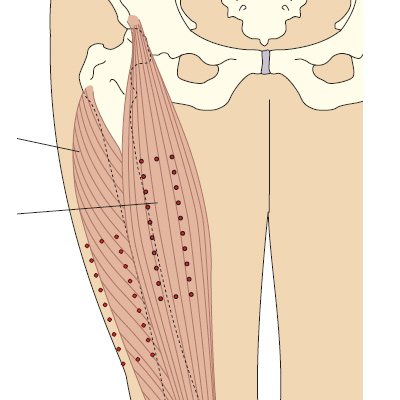
- shoulder (deltoid muscle)
Preparation for the procedure
In accordance with modern requirements, before administering an intramuscular injection, the nurse must:
- Invite the patient into the treatment room or approach him in the ward, introduce yourself, identify the patient and inform him about the purpose and progress of the upcoming procedure, emphasize that everything is done as prescribed by the attending physician
- Make sure that the patient has informed consent for intramuscular administration of the drug with a note about the tolerability of the administered drug. If documentation is missing, check with your doctor for further steps.
- Wash hands hygienically and dry with a disposable paper towel. Treat the skin of your hands with a special antiseptic, do not dry them, wait for them to dry. Wear a mask and non-sterile gloves.
- Take a bottle or ampoule with the medicine, check the expiration date, check the name with the doctor’s prescription, make sure there is no external damage, and evaluate the transparency of the solution.
- Take a syringe of the required volume with a needle of sufficient length and thickness, check the expiration date and integrity of the packaging, and open the syringe.
- Draw up the medicine into the syringe.
- When taking a drug from an ampoule : check the name, appearance, dosage and expiration date of the drug, shake the ampoule so that the solution is in its widest part, file the neck, wipe the neck with an antiseptic napkin, break the neck, draw the drug.
- When taking a medicine from a bottle : check the name, appearance, dosage and expiration date of the medicine, use scissors or tweezers to bend the part of the cap covering the rubber stopper, wipe the stopper with an antiseptic napkin, place the needle through the stopper into the bottle at an angle of 90 degrees so that the cut was inside the bottle, turn the bottle upside down, draw the solution into a syringe.
- Replace the syringe needle with a sterile one, release the air from the syringe without removing the cap from the needle, and place the syringe in a sterile tray. Place wipes for treating the injection field in the same tray.
- Invite the patient to take a comfortable position lying on the couch.
- Select the injection site, inspect and palpate it for signs of inflammation and infiltration. If any, change the injection site and inform your doctor.
Read also: Measuring body temperature: algorithm. Types of thermometers
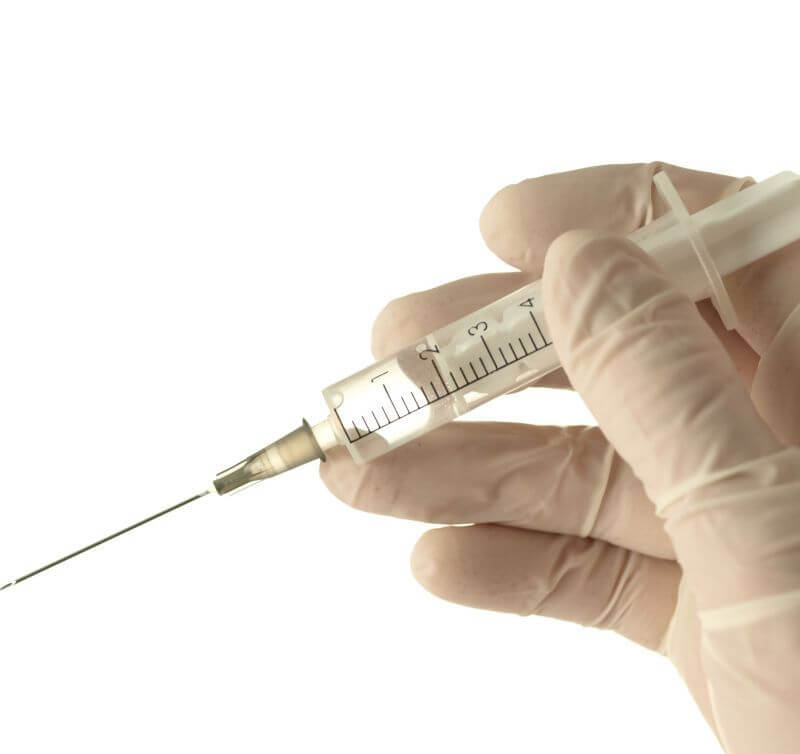
Basic safety rules when injecting yourself in the thigh
Injections in the thigh must be given to yourself with extreme caution so as not to damage large blood vessels and peripheral nerves.
A prerequisite for self-therapy with injection administration of drugs is compliance with the following safety rules:
- it is strictly forbidden to reuse a disposable syringe and needle, since such actions are fraught with infection of the tissues in the area of the injection;
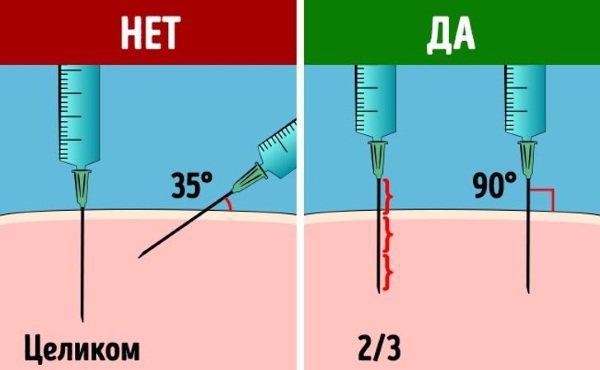
- if it is necessary to carry out long-term drug therapy using intramuscular injections, it is necessary to alternate the left and right sides of the thighs in order to eliminate the factor of the formation of extensive hematomas;
- You should not inject into the same point of the thigh tissue, as this will lead to the appearance of symptoms of acute pain and will also cause the development of inflammatory processes;
- use imported syringes, as they are distinguished by sharper and thinner needles that do not cause severe pain in the area of their insertion, having minimal trauma to epithelial and muscle tissues;
- before intramuscular administration of the drug, it is always necessary to perform an antiseptic treatment of the skin surface to avoid complications;
- If minimal signs of an inflammatory process or the onset of subcutaneous bleeding or the formation of an extensive hematoma appear, you must immediately seek medical help.
It is important to remember that at the moment of self-injection into the outer thigh, the lower limb should be relaxed. For this purpose, the leg is placed on a flat surface, since excessive tension can provoke involuntary contraction of the muscle with damage to its tissue structure. A similar reaction occurs immediately at the moment of needle insertion.
Intramuscular injection: algorithm of actions when performing the procedure
- Select the injection site.
- Treat the patient's skin with antiseptic wipes twice. First treatment - an area of about 10*10 cm is wiped with a napkin in the same direction. Then the second treatment - with a second napkin, the same area is 5 * 5 cm.
- Stretch the patient’s skin in the area of the intended puncture with the thumb and index finger of one hand to increase the volume of the muscle and facilitate insertion of the needle.
- Take the syringe in the other hand (index finger on the piston, little finger holding the needle cannula, the rest on the cylinder), place it perpendicular to the surface of the patient’s body. For intramuscular injections into the thigh and shoulder, the syringe must be held at an angle, like a pen, to prevent damage to the periosteum.
- With a quick, easy movement, insert the syringe needle at an angle of 90 degrees to 2/3 of its length. Pull back the plunger slightly to make sure there is no blood in the syringe.
- Holding the cannula of the needle and pressing the piston, slowly inject the medicinal solution into the muscle.
- Pressing the antiseptic napkin to the puncture site, quickly remove the needle.
- Continuing to press the napkin, lightly massage the injection site.
- Place the napkin and syringe in the waste tray.
- If necessary, apply a sterile adhesive bandage to the puncture site.
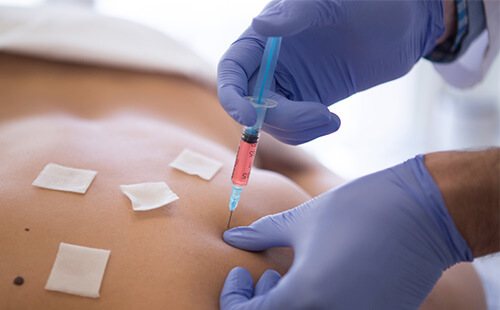
How to give a subcutaneous injection correctly
In some cases, injections must be given subcutaneously. Injections are allowed in different areas:
- the upper part of the left or right buttock;
- the back of the shoulder (another person gives the injection);
- thigh (middle third of the outer or anterior surface);
- stomach - any area, with the exception of a circle around the navel with a radius of 5 cm).
The preparation for the procedure and the execution of the injection are exactly the same. The injection is administered with a quick and confident movement, orienting the needle at a right angle to the surface of the skin. Moreover, when choosing a location, it is worth excluding those areas where there are redness, bruises, wounds, painful areas, stretch marks or scars.
As a rule, administering an injection intramuscularly or subcutaneously does not pose any danger to the patient. But sometimes complications may occur in the form of fever, swelling, redness, allergic reactions (itching, rashes) or other side effects. In this case, you should not hesitate - you need to immediately call emergency help.
End of the procedure
- Place used needles in a Class B sharps waste container using a needle remover.
- Place syringes, gloves, used wipes in a Class B waste container.
- Wash your hands hygienically and dry with a disposable towel.
- 10-15 minutes after the procedure, inquire about the patient’s well-being and his reaction to the administration of the drug. If there are complaints about the patient’s health, inform the attending physician.
- Enter information about the intramuscular injection procedure into the medical documentation.
How to choose a syringe for giving an injection?
Depending on the specific procedures being performed, syringes may have different types of connections to the needle.
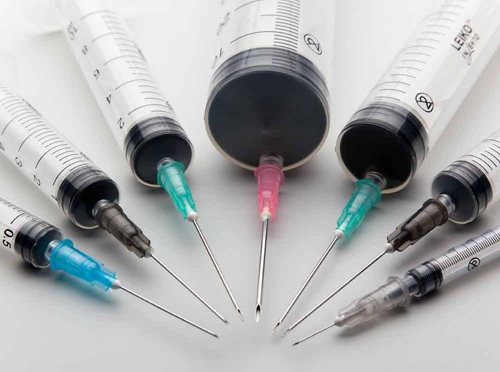
| Compound | Description | Purpose |
| Luer slip | The needle is put on the syringe | Standard for syringes 1-100 ml |
| Luer lock | The needle is screwed in | The design ensures reliable fixation of the needle. Used for collecting biomaterial and puncturing dense tissues. Popular in psychiatry. |
| Catheter | The needle is not provided by the design | It is used when feeding through a tube or when it is necessary to administer a solution through a catheter. |
| Integrated needle | Non-removable needle, integrated with the cylinder | Design in syringes up to 1 ml inclusive. Most often these are insulin syringes. |
Standard Classification of Medical Syringes
The classification by volume will be as follows:
- Small volume syringes - 0.3, 0.5 and 1 ml. They are used for precise administration of the appropriate volume of a drug in endocrinology (insulin), phthisiology (tuberculin), neonatology, as well as for conducting allergy and intradermal tests. They can be marked both in milliliters and in units of substance (in increments of 1, 0.5 or 0.25 units). The connection type is mainly an integrated needle.
- Syringes of standard volume - 2, 3, 5, 10 and 20 ml. The most common. They are used for injections of all types (intramuscular, intravenous, subcutaneous) and are available with mounts for both types of needles - Luer and Luer Lock. They are usually marked in milliliters in increments of 1 ml.
- Large volume syringes - 30, 50, 60 and 100 ml. Those with a Luer Lock connection are usually used in infusion pumps and perfusors (syringe pumps - devices that allow, for example, in addition to the drug from a dropper, to administer medicine from a syringe at a certain specified speed). Syringes with a catheter connection are more often used for feeding through a tube, administering medications through the urinary canals and drainages, and washing abscesses and cavities. They are marked in milliliters in 2 ml increments.
Now, after we have learned how to choose the right syringe and needle for an injection, we need to remember the rules for their subsequent disposal after use.
Intramuscular injection: possible complications
- Needle breakage
- Traumatization of the periosteum
- Damage to nerve trunks
- Formation of infiltrates, hematomas, abscesses
- Oil, suspension embolism
- Thrombophlebitis
- Soft tissue necrosis
- Allergic reactions
- Infection with parenteral hepatitis, HIV infection
Read also: Measuring blood pressure: methods, manipulation techniques
All facts of unusual reactions and complications after them must be documented. If you suspect a complication has developed, you must inform your doctor and senior nurse. Early detection of changes in the patient’s well-being will make it possible to alleviate or prevent the development of a full-fledged complication that may result from an intramuscular injection.
Local anesthetics
For local anesthesia, anesthetics are used - agents that relieve pain in one place. They are used for anesthesia during dental treatment, joint pathologies, and simple operations.
- Novocaine
- a product based on procaine that has been popular for a long time. It acts locally, is used for blockades of the spine or joints, relieves pain in dentistry, and for diagnostic procedures. The peculiarity is that it turns off the sensitivity of nerve endings. You can inject the product into 3-4 points, then the anesthesia will be more effective. It is easily tolerated and quickly excreted by the kidneys.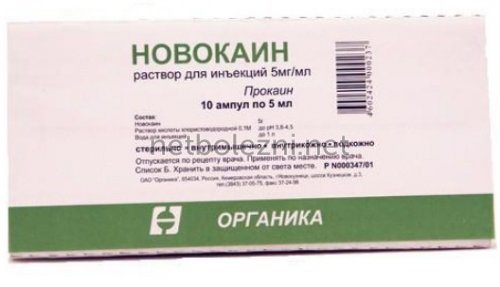
- Lidocaine
is a stronger anesthetic, with the active ingredient lidocaine hydrochloride. Blocks the conduction of nerve impulses, dilates blood vessels and relaxes muscles. Used in dentistry, traumatology, surgery. Injections are made into the gums, joints, and soft tissues.
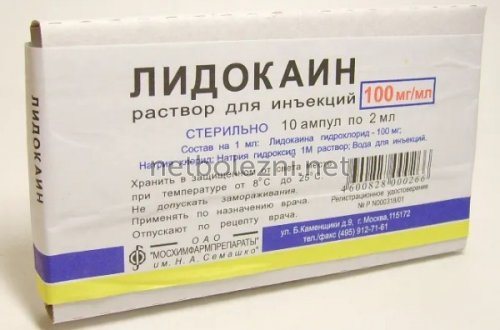
These are the most common anesthetics, despite the fact that they cause many side effects. Especially often these are allergic reactions, heart rhythm disturbances, decreased or increased blood pressure.
